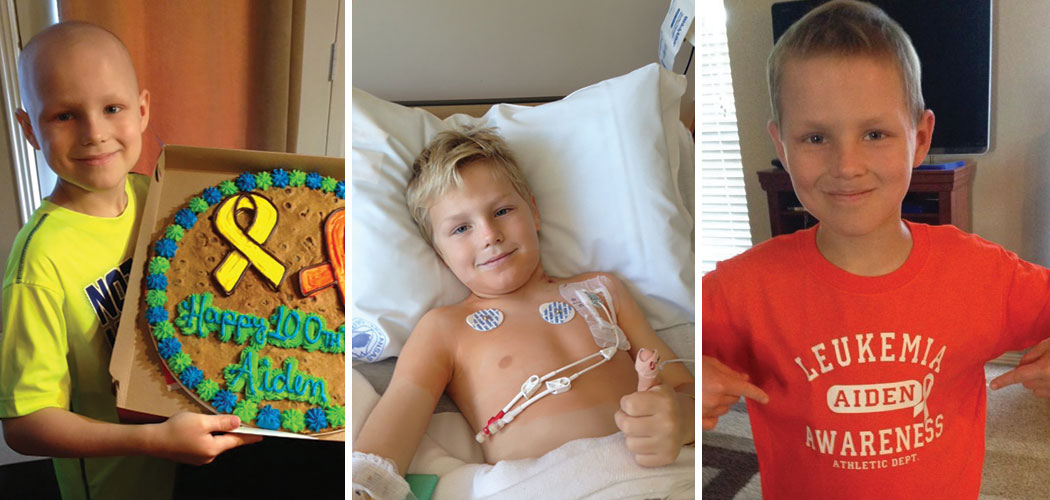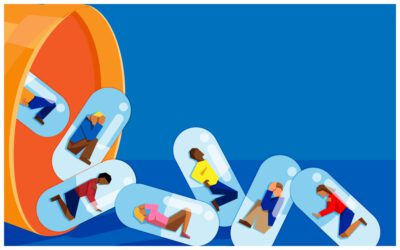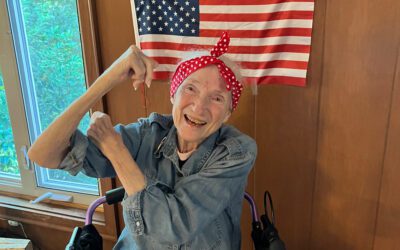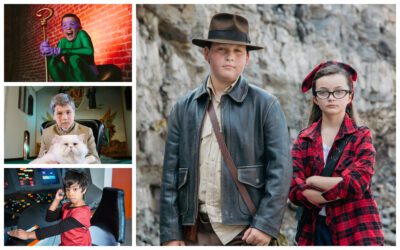[title subtitle=”words: Marla Cantrell Images: courtesy Amber Alder”][/title]
The sun is out, a big yellow ball in the sky, and Aiden Alder, eight years old, is standing in the doorway of his Fort Smith, Arkansas home, his hand shielding the light from it. He is wearing a yellow shirt, equally as bright, and blue jeans, and white socks that help him slide along the kitchen floor, something he loves to do.
In his free hand, he is holding a clutch of beads, white and yellow and red and green. He has strung them together, and they would easily be three times as tall as he is if you laid them on the floor and had him lie down beside them.
“Look at my Beads of Courage,” he says, and pulls them taut between his two hands, holding them out the way a seamstress might hold a length of ribbon, the way a hunter might hold the carcass of a conquered snake.
At eight, Aiden knows a lot about courage. He holds up the long part of the string where white beads click against each other. White signifies chemotherapy treatments. Red, blood transfusions. Yellow, nights in the hospital. The ones with stars on them signify surgeries. The ones with cartoon faces, hair loss.
Each of these was given to Aiden by nurses at Arkansas Children’s Hospital in Little Rock or nurses at Dallas Children’s Hospital. He earned every one fighting leukemia, not once but twice.
Aiden’s mom, Amber Alder, describes what it was like to get the first diagnosis. He was two years old and four months. He’d been anemic and bruised easily. He also had what looked like a rash, but was actually blood vessels that had burst just beneath his skin.
What she remembers about that day is how gentle the medical staff was. They told her the blood tests should not take long, maybe ten minutes tops, but she watched as patient after patient came and went. It wasn’t until the waiting room emptied that they took the family back and gave them the news, and by then they had everything worked out, including the helicopter that would fly Aiden to Arkansas Children’s Hospital in Little Rock.
She remembers the long drive to Little Rock with Aiden’s dad, knowing Aiden was already at the hospital, in the ICU. They raced to his bedside when they arrived at two in the morning, and Amber slid her hand through the metal bars that kept him safe inside the crib.
She held on until daybreak. Amber was a young mom, just twenty-two at the time, and she remembers feeling as if the whole world had broken, as if it might never be put back together again.
As she tells the story, she’s careful as she describes his treatment. Aiden has gone to his room to retrieve a poster that reads Welcome Home Aiden, which was in their yard when he returned home from one of his hospital stays.
When he comes back into the living room for a few minutes, he is grinning. He says he remembers his mom at his side, he remembers watching Saving Nemo. What she remembers is hearing his treatment would take six months, and how long that felt, how insurmountable.
His diagnosis was Acute Myeloid Leukemia. “Their (the specialists’) words were, ‘If you’re going to get leukemia, this is the one you want because it has a very low rate of returning,’” Amber says. “Also, the sub-type he had has no statistics on it returning, that’s how much of a rarity it is. And also, after five years, leukemia usually doesn’t come back.”
Once Aiden was in remission, Amber was overcome with gratitude. She watched him carefully, as did his doctors, seeing him regularly, routinely testing him. It was a tough chapter in their lives, but she believed it was over. When the five-year mark hit, they all celebrated.
And then, the day before Halloween in 2013, five and a half years after his first diagnosis, she was waiting with Aiden at an optometrist’s office. To make the time go faster, he was trying on glasses. As she helped him, she brushed aside his hair. There on his face was the same rash she’d seen when he was two years old. She felt her legs go weak, her heart race. When Aiden asked what was wrong, she assured him everything was fine, although it was not fine, and would not be again for a very long time.
The doctors started tests immediately. For a time, they hoped it was a powerful virus, causing his blood counts to fluctuate, but it was not. The cancer that was not supposed to return had made a comeback. Amber knew that when Aiden was only two years old, he had a limited view of how things worked, but now he understood what illness was, and what the outcome might be.
Still, there was such comfort in returning to Arkansas Children’s Hospital. They knew many of the nurses, and Aiden had the doctors that had cared for him for so long. They made a plan: three rounds of chemo to get Aiden back into remission, and then a trip to Dallas for a bone marrow transplant.
“When we got to the wing of the hospital, there was a nurse I knew named Paige. I have a picture of her giving Aiden his cake after his last chemo treatment when he was two. She saw me, and she said, ‘Can I hug you or no?’ And I said, ‘Please.’ She held me tight and I kind of melted. I didn’t cry, but I needed that right then, and she knew it.
“Dr. Stine is Aiden’s oncologist, and he went in his room with me to tell him. Aiden wasn’t crying; I think he seemed disappointed. And he wanted to know why this had happened. I told him God has a reason for everything, even if we don’t know what it is. Everything that happens affects everything else in your life. I told him maybe it was so that he could get through this and show other kids that they can make it.
“He’s taught me what bravery is. There was only one time, right in the beginning, when he would just lay there in bed facing the door and wouldn’t talk. He finally said, ‘I don’t want to tell you.’ And I said, ‘You can tell me anything.’ He finally said, ‘I don’t want to die.’ I choked up, and then I pulled it together and smiled and said, ‘Aiden, are you kidding me? You’re not going to die! You’re going to have some chemo and medicine, and you’re going to get better!’ I made it seem like he was being ridiculous.”
Treatment started on November 8, 2013. They were home for Thanksgiving, then back again for more chemo that lasted until Christmas. In February 2014, they headed to Dallas, where Aiden underwent eight days of intense chemo “to pretty much kill all his bone marrow,” Amber says, just before the bone marrow transplant. The intense treatment caused ulcers to form in his mouth and throat, and he was throwing up a good deal, so sick and so ready for it to be over.
On February 24, he had his transplant, thanks to the kindness of a police officer who’d signed up for the bone marrow donor registry. He was a nine-out-of-ten match for Aiden, which is incredibly good, and he wrote Aiden a letter and told him about his life. The officer had a ten-month-old baby. He said he was happy he could help. He sent Aiden a badge and a police belt.
“I wrote the thank you letter to him sixteen times, trying to get it just right,” Amber says, and for the first time since she started telling this story, her voice catches. “I just couldn’t express the thank you for the selfless thing this police officer did.”
The marrow was taken from the officer’s hip bones and was then administered through the line that was already surgically installed in Aiden’s body, much as a blood transfusion would work. He stayed in the hospital twenty-eight more days, and then he was well enough to move off campus, into the nearby transplant wing of the Ronald McDonald House.
It might have helped Amber to talk to other parents going through the same thing. But she didn’t want to leave Aiden’s side, and so she nestled inside their apartment, keeping him away from visitors, making sure he wasn’t exposed to outside germs. For two months they stayed. “By then, he wasn’t so sick. We’d always been close and had this strong bond, but we got even closer. He can talk to me about anything now. He can talk about the gross things – chemo makes gross things happen.”
One of the hardest parts of this time was that Amber had to leave Aiden’s younger sister at home in Fort Smith in the care of her grandmother who was doing everything in her power to keep life as upbeat and normal as possible.
Still, Amber’s heart ached for her daughter, and she felt the tears well up every day when she’d get pictures from home.
Even when they got back, Amber remained diligent, vacuuming her house twice a day, making everyone wash their hands often, sterilizing everything that could be sterilized. “I wouldn’t let anyone come over. It was scary.” When she worried, she felt as if she shouldn’t, as if worrying was a form of negativity. Aiden had made it through treatment. He was in remission. She should stay positive. She concentrated on the joy of everyday life, of eating a meal together, of having Aiden grab his favorite fuzzy blanket – the one he’d missed so much while in the hospital – and snuggle beside her on the couch to watch a movie.
“Today in the car, Aiden and his sister were cracking up at each other. I watched them, and I was so thankful. Each day I wake up, and I say, ‘Thank you, God, for this day, for my children, because anything can happen, anytime. Anytime.”
Amber has had that “anytime” happen twice in her life. The trials have been hard, but she’s grown from them. “I’ve learned people have bigger hearts than you think they do,” she says. “Like everybody else, I could judge people before this happened. Now I look at them like they’re the most wonderful people in the world.” Amber laughs then and turns the conversation on its head. “I also know a lot about blood,” she says, “a crazy amount about it.”
Aiden has ambled into the kitchen where his socked feet slide across the waxy floor. He stops, grabs the banana he’s been eating, and walks into the living room. He brings with him a photograph from a trip two years ago to Hawaii. In it, his hair is so blond it is nearly blinding. Since going bald and re-growing hair, he’s now a dark blond. His teeth have soft spots in the enamel, another effect of treatment. He lifts his shirt and reveals an inch-long scar where the port that delivered chemo used to be. He palms the port in his small hand: it is purple, triangular, and finally, thankfully, useless.
He finishes the banana, goes to his room again to retrieve a stack of handmade cards from his classmates at Immaculate Conception School in Fort Smith. While he was away all those months – he left in October 2013 and returned in August 2014 for the first day of third grade – the school did all it could to help.
Those at Immaculate Conception held a fundraiser, selling T-shirts that read Team Aiden: Heal me, Lord, that I may be healed. Save me that I may be saved. For it is You whom I praise. In morning assembly, the staff recorded the students singing songs and prayers and sent them to Aiden as a way to lift him up through those tough times.
Aiden flops in a chair, his legs thrown across the arm. He picks up card after card, and the ones who wrote the longest passages seem to be the girls from his class. He lifts the final one, covered in hearts and glitter, unfolds it carefully and reads aloud: Hey, Aiden, we miss you. You are a great friend. Hope you feel a lot better. You’re really great. We love you. I love you. You are great, you are cool, you are awesome.
He blushes, covers his eyes with his hands, and sighs. At eight, a girl’s attention is a wonderful and confusing thing. Aiden changes the subject quickly, talks about Day 100 after his bone marrow transplant when he was finally able to eat food that hadn’t been washed and cooked by his own mother. He asked for a Cookie Company giant cookie and Geno’s pizza. He ate the pizza so fast things got ugly. “I got sick, and a quarter-size of pizza flew out of my nose!” Aiden says, and he laughs the laugh of a little boy who embraces the grossness of that statement.
Aiden talks more about getting sick, and the talk turns serious. What has cancer taught him? “That nobody wants to throw up,” he says. And then he adds. “Nobody.”
He rises from the chair and starts to go back to his room to play. But he stops long enough to answer the question of what he will do when he’s grown and can do what he pleases. “I want to be a scientist; I want to be a chemist,” he says. “I like science experiments where you mix chemicals. I have a science kit my dad bought me with alive goo, magnetic goo, and glow in the dark goo.”
It seems logical that Aiden would become a scientist. Science played a role in saving his young life on two occasions. He stops in the hallway, the bundle of construction-paper cards still in his hand. He turns back once, grinning, and his smile lights every dim corner, it slips through the doorways and windows, it seems to illuminate the soft edges of this winter day, brighter than the sun, even though the sun is brilliant in its shining.
—
For more on Aiden’s story, check out the Facebook page, Aiden Alder, Day in the Life of a Courageous Little Boy. To find out more about how you can join the National Marrow Donor Program, visit BeTheMatch.org.




